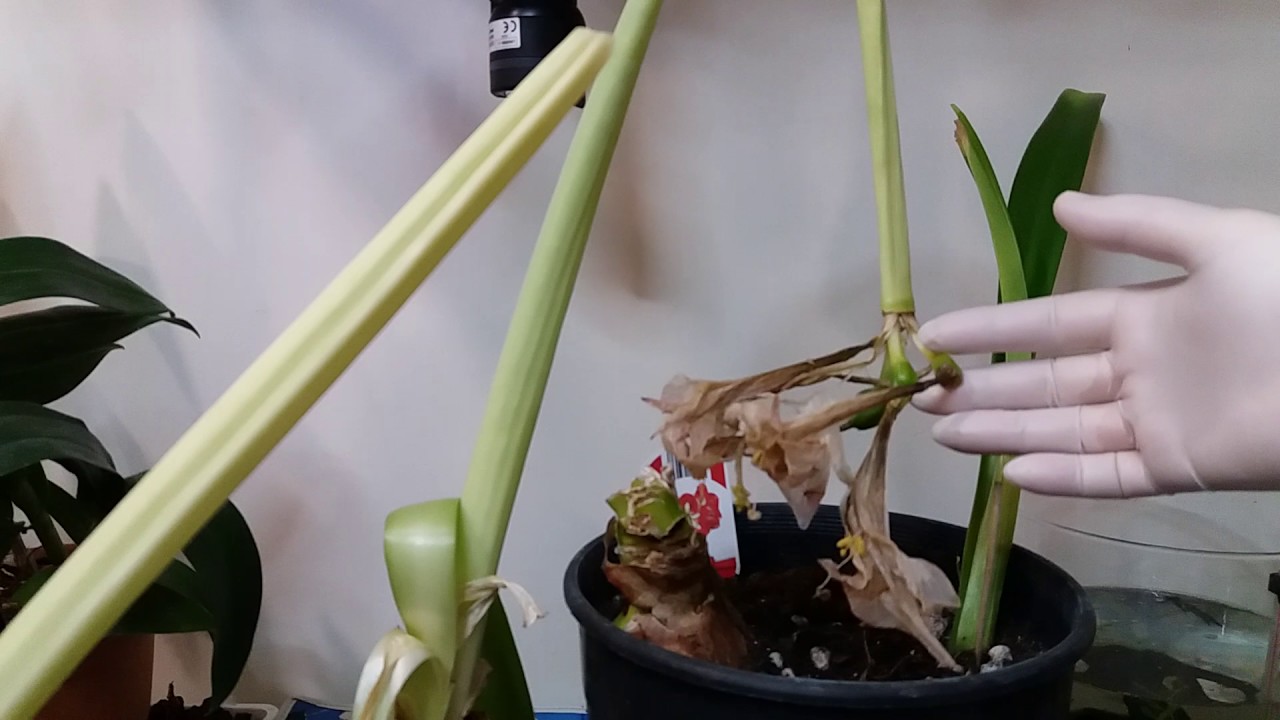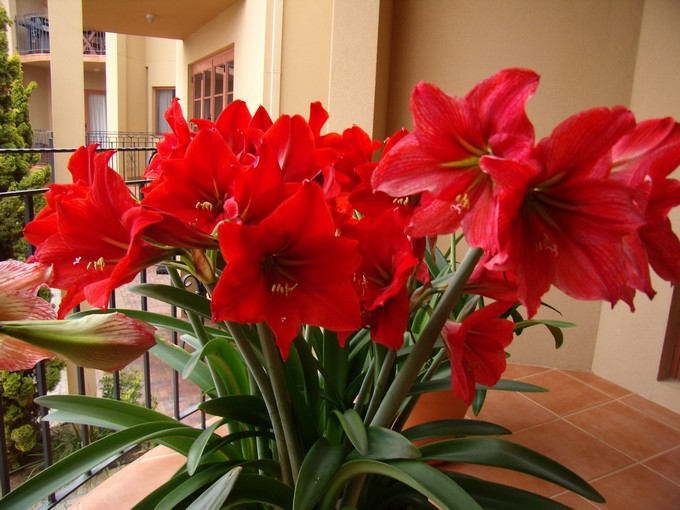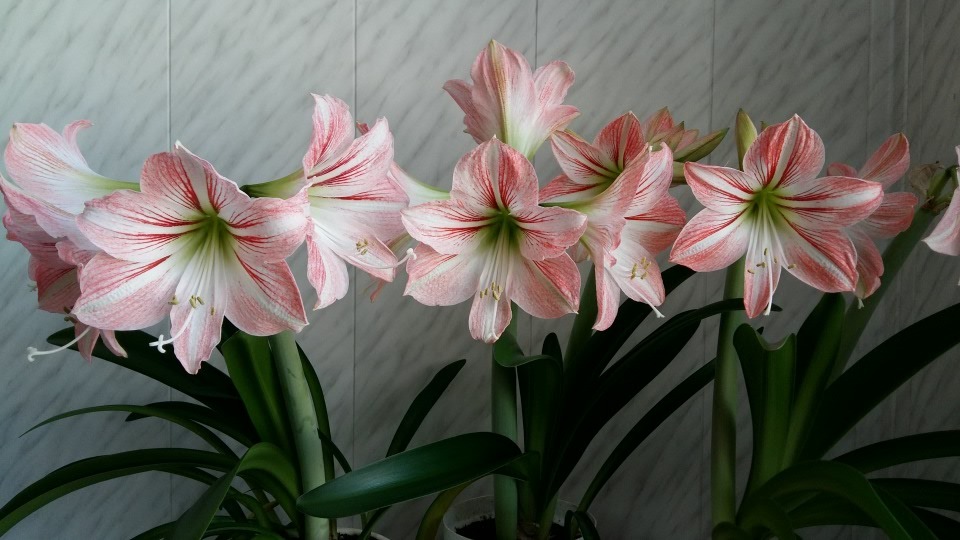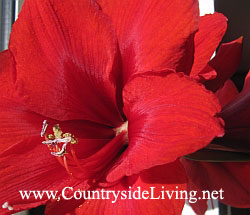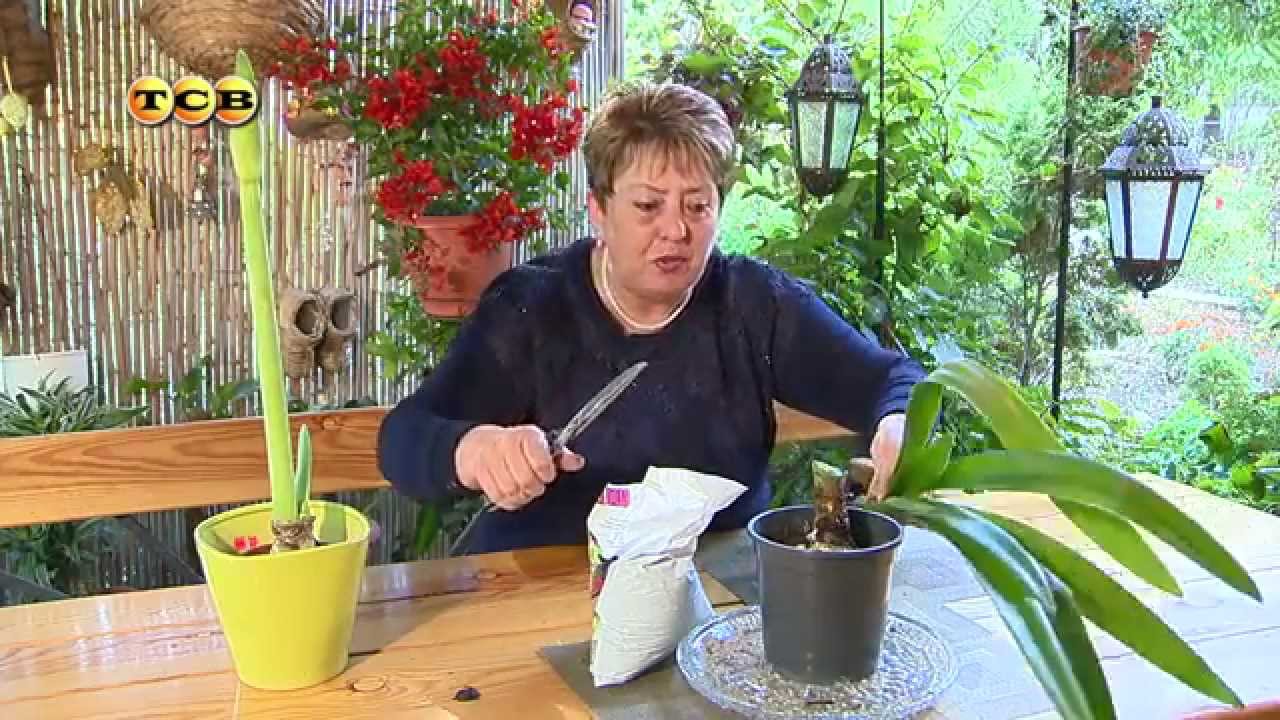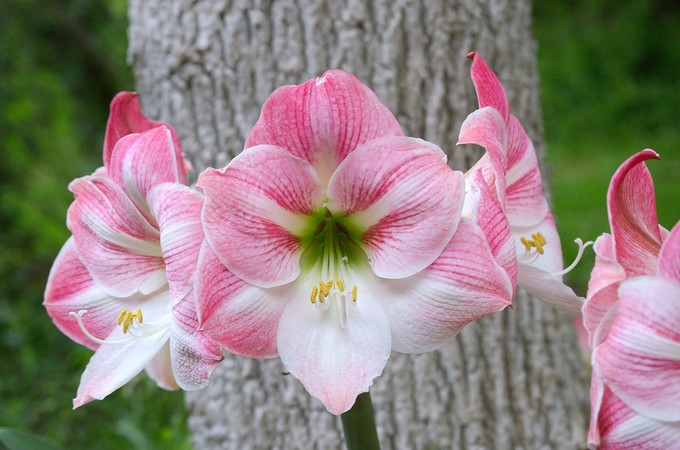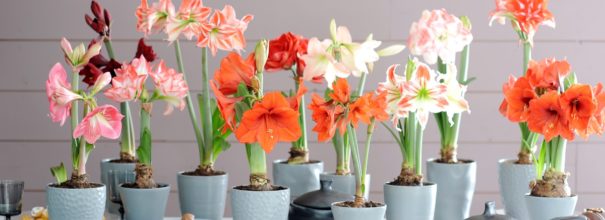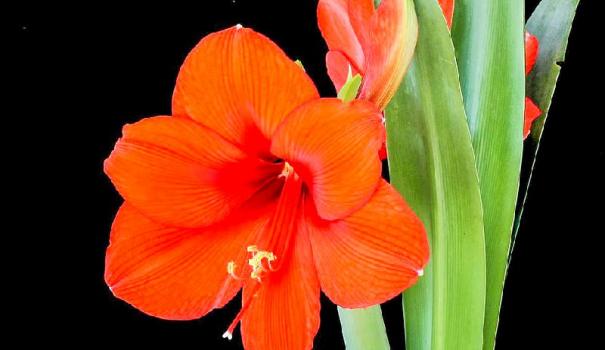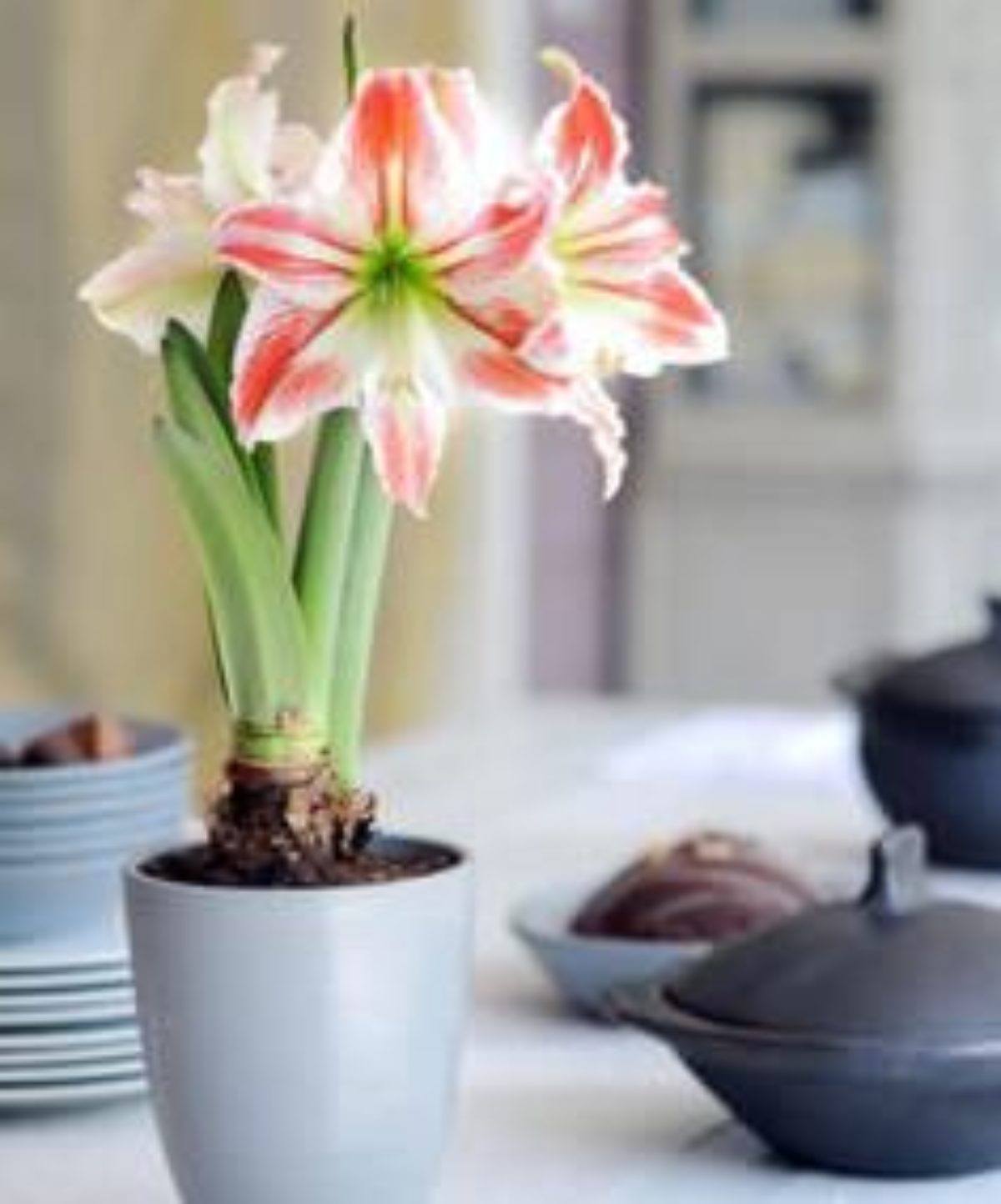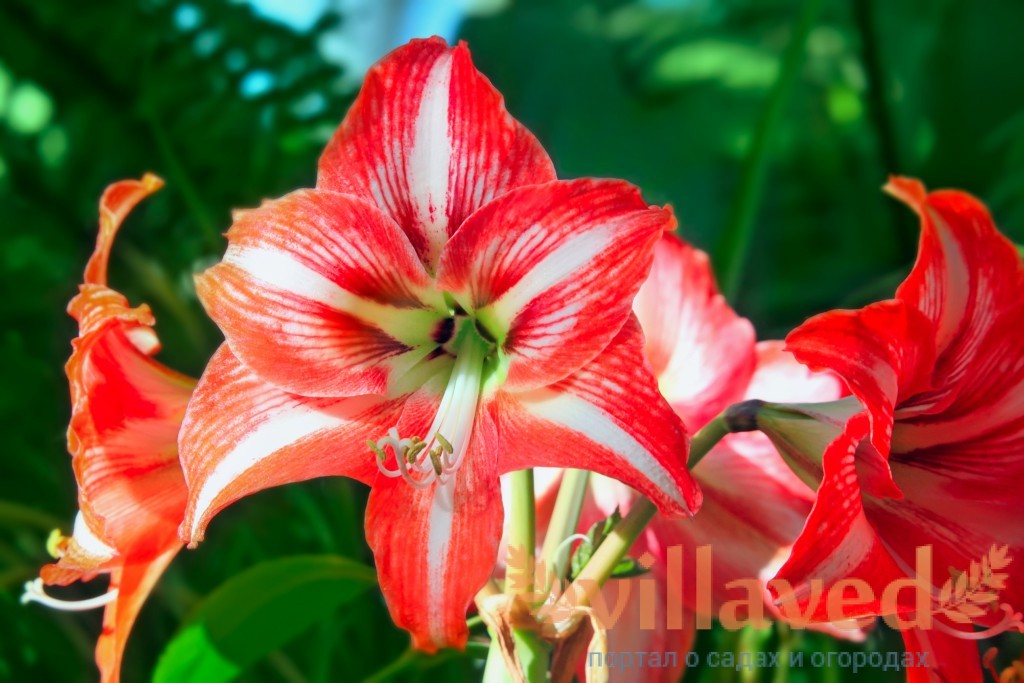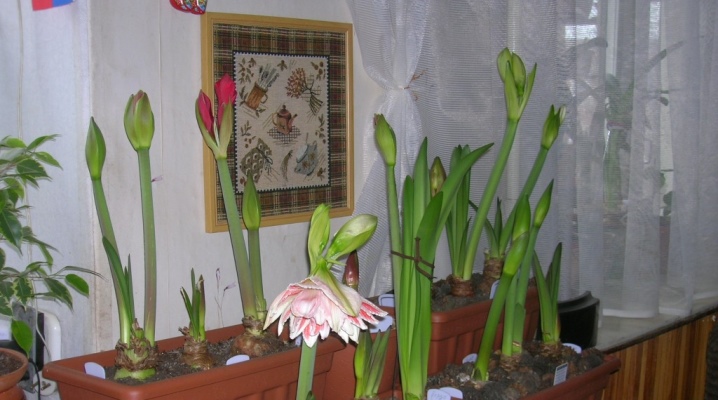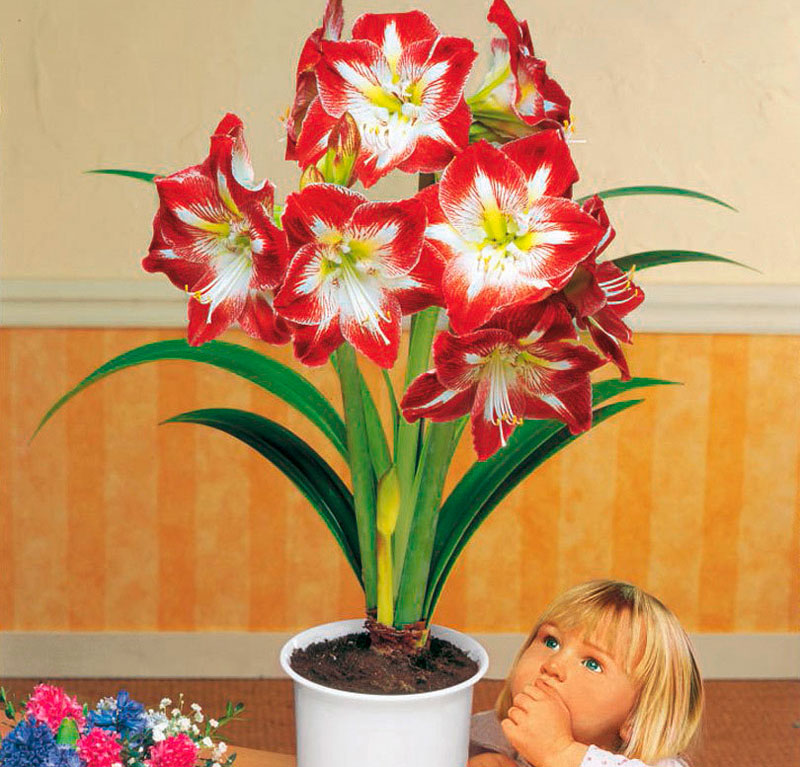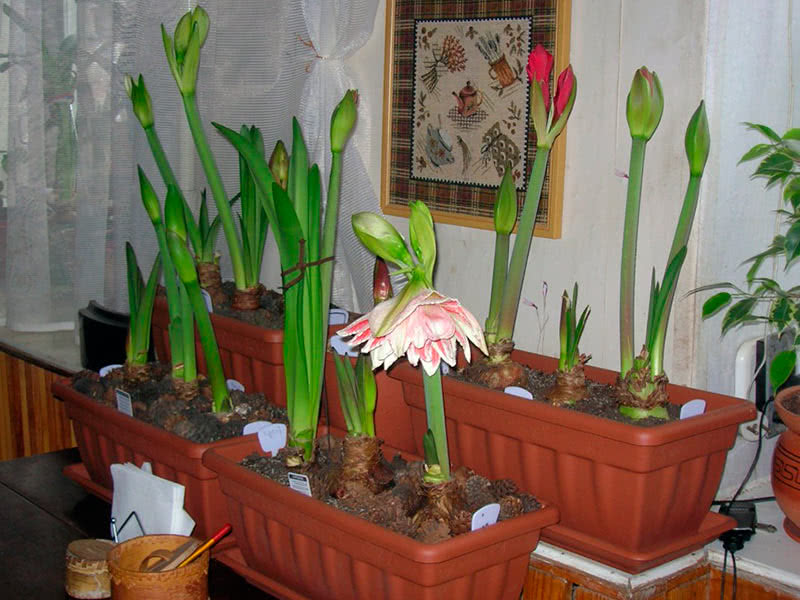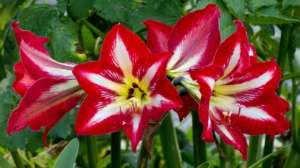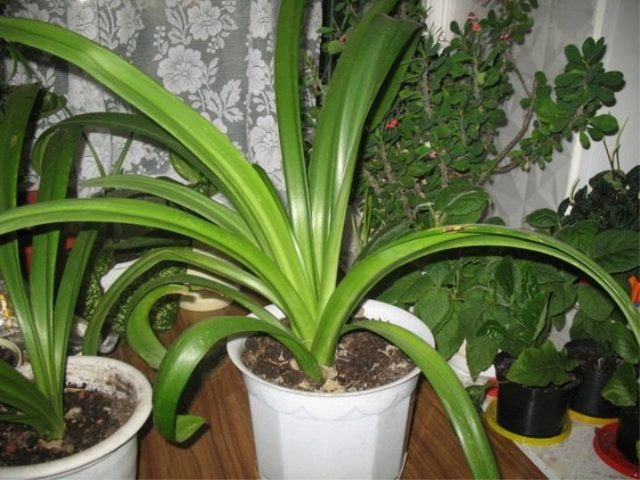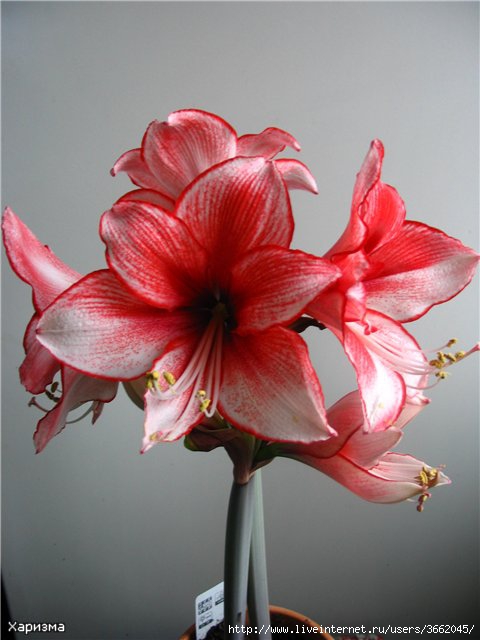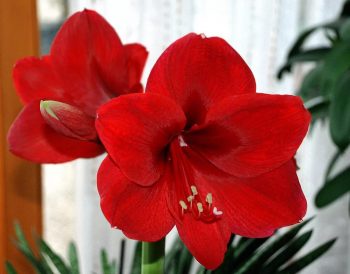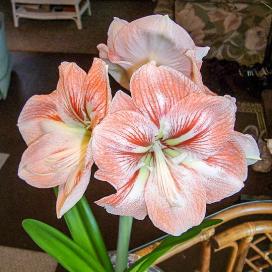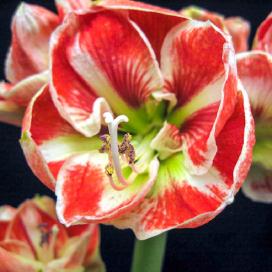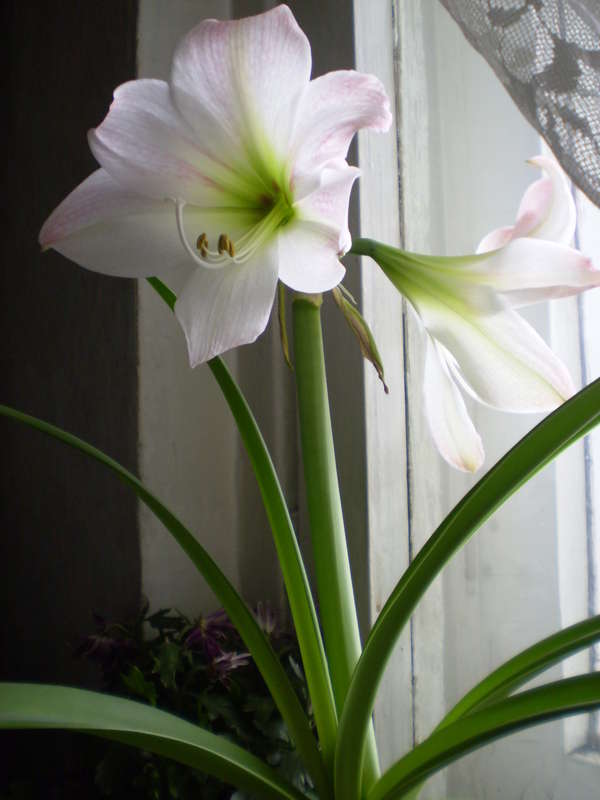Why hippeastrum does not bloom
Bulbous plants are not capricious, but there are certain rules of care that cannot be violated.
If the hippeastrum is not blooming, it probably has not been properly cared for.
- Hippeastrum definitely needs a rest period. Between flowering it is necessary to organize a "vacation" for the plant. To do this, hippeastrum is sent to a dark, cool place for 3 months. Usually, the dormant period occurs in autumn, but the flower itself will tell you when it needs to rest - it will begin to shed its leaves.
- The soil in the pot must be nutritious. Only in this way will hippeastrum be able to gain strength for flowering. It is better to buy a special soil for amaryllis.
- It is necessary to transplant hippeastrum every year. During this time, the plant manages to draw out all the useful substances from the soil, which means that you can not wait for the next flowering.
- Hippeastrum are very light-requiring, they feel bad in the shade. It is better to grow these plants on the southern windows. If the room faces north, you can buy a special phytolamp and turn it on, continuing too short daylight hours.
- The ideal temperature for this plant is 18-20 ° C. If the room is hot, the hippeastrum will bloom, but its petals will quickly fade. During the dormant period, it is necessary to provide the plant with coolness - up to 13 ° C.
- The hippeastrum should not be too deep in the ground. When planting, you need to mentally divide the bulb in half and dig only the lower part into the ground. The design seems unreliable at first, but the flower will be better this way. And when the bulb grows a normal root system, it will firmly settle in the ground.
If the plant does not bloom for a long time, most likely one or more of the rules of care have been violated. This is the most common answer to the question why hippeastrum does not bloom at home.
Care features

After planting, it is required to follow the recommendations of the content of the hippeastrum: its appearance and well-being depends on it
Lighting

Well-organized lighting
The plant prefers diffused light. It is better to place it on the sill of the east or southeast window.
It is categorically undesirable to put it on the north side: it will be too dark for a native of the tropics, he will refuse to grow and bloom. The flower should be shaded from bright daytime sunlight if it grows on the south side.
Hippeastrum stretches after the sun, therefore, during flowering, the plant should be regularly rotated around the axis so that the flower cap is formed symmetrically.
Temperature regime

Optimum air temperature in summer + 20-25 ° С
In the summer, a room temperature of + 20-25 degrees is suitable for hippeastrum. If it is too low, you can not wait for the flowers to appear. In winter, they are kept in conditions of low temperature and lack of moisture so that the plant can rest.
Watering and humidity

Watering the hippeastrum with a watering can
In the initial phase of the growing season, the flower is watered carefully and sparsely. The amount of watering is increased only when the plant releases the arrow of the peduncle. This means that it has entered a phase of active development.
At the same time, it is important to keep the soil moist, not wet.
Ideal for hippeastrum watering through a tray. It is advisable that water does not fall on the surface of the bulb.
Spraying is not required for the plant: air humidity can be maintained using artificial humidifiers. It is also recommended to regularly wipe the dust off the leaves with a sponge and give the plant a warm shower. When the flowering period is over, watering is gradually reduced.
When the peduncle has grown stronger and has grown to 15 cm, you can water the ground with a weak solution of potassium permanganate, and after a few days, for the first time, add a little fertilizer with phosphorus. This will ensure faster bud formation and more lush flowering.
Top dressing

Phosphate-potassium fertilizer
In spring and summer, the plant can be fed with mineral phosphorus mixtures. And it is undesirable to introduce compositions with liquid nitrogen: they can lead to a dangerous disease - root rot.
Top dressing is applied every 2-3 weeks. Stop fertilizing the plant when preparing it for a dormant period.
Popular plants for landscaping and decorating a children's room and premises of kindergartens. Recommended and Banned (25 Photos & Videos) + Reviews
What do you need to do after purchase?
The peculiarity and distinctive feature of the hippeastrum is the peduncle - a hollow tube, and, for example, in Ammarilis, the flower arrow is filled with tissues. The peduncle is cylindrical, the surface is smooth, covered with a waxy bloom. High arrow stretches 40-80 cm, depending on the type and age of the flower. The color is light green, some varieties are dark.

After flowering, the flower arrow at the hippeastrum gradually dies off. Cutting off the peduncle immediately is dangerous, the integrity of the bulb is damaged (the risk of rot and infection with harmful infections). First, only wilted flowers are removed.
Professional Tips:
- Buy Hippeastrum in the fall or spring (to immediately transplant).
- Carefully examine the bulb itself (it must be firm, juicy, at least 6-7 cm in diameter, without rot, reddish marks and seals).
- Turn the pot over, the root canals should be visible through the drainage holes).
The landing procedure is simple:
- A pot is selected by the size, the inner surface is treated with steam or boiling water.
- Prepare the substrate and drainage, disinfect (ignite in the oven or spill with disinfecting drugs).
- Cut off dry and rotten fragments, carefully clean the neck and bottom, cut off too long processes.
- The onion is treated (soaked for 20 minutes) with disinfecting drugs (Maxim, Aktara).
- Planting bulbs are dried.
- 2-3 holes are made in the container (for the outflow of water and air exchange).
- Pour 3-4 cm of drainage material to the bottom.
- Earthen mixture is poured almost to the top.
- The bulb is placed in the center, a small hole is made.
- The roots are laid evenly.
- Deepen by a third of the growth of the bulb.
- Along the edge, gently watered with a stimulant solution (Epin, Zircon, Extrasol).
- They are placed in a bright, warm place.
How to rejuvenate an onion?
In this case, the method of division-rejuvenation of the mother tuber will help. The procedure is not easy, it requires step-by-step instructions:
After flowering, in November, when the bulb has accumulated nutrients, it is ready to divide.
Cut off the entire aerial part with a sharp knife.
The onion is cleaned from the outer layer (the top shell is removed, the neck is cut).
The top layer of the soil is carefully removed with a sharpened tool (the main thing is not to damage the roots).
Make 2 deep vertical cuts, up to the very base, crosswise (the segments should be exactly the same in area).
Along the cuts themselves, the needles (wooden or plastic) are laid horizontally so that the segments do not touch each other.
It is important to regularly moisten and fertilize the soil (overdrying and lack of nutrition will ruin the whole process).
After about 4 months, the first daughter onion appears.
Within 5-6 months, from the moment of division, the old bulb forms more than 5 children.
In the spring, the children are separated and planted separately.
Why hippeastrum does not bloom - 2 ways to solve the problem
The answer to this question is simple: the flower is not properly looked after. Hippeastrum is useful to take out in the garden for the summer.It is better to place it in the shade under a tree, where the plant will not suffer from too active sunlight, lack of moisture.
It is important during this period to regularly water and periodically feed (full mineral fertilizer + 0.5 teaspoon of sodium humate per bucket of water). On such "summer holidays" the flower will gain strength and after a period of rest it will delight you with beautiful buds. Hippeastrum does not bloom if the soil is not suitable
It needs to be transplanted into light soil. You need to transplant into new land every 3 years. Low in nutrients - feed the plant every 2 weeks with complex fertilizer
Hippeastrum will not bloom if the soil is not suitable. It needs to be transplanted into light soil. You need to transplant into new land every 3 years. Few nutrients - feed the plant once every 2 weeks with complex fertilizer.
Hippeastrum does not bloom in an oversized pot. Transplant the plant into a small, shallow one, the diameter of which is one centimeter larger than the diameter of the bulb.
The plant did not have a dormant period - stop feeding and watering, cut off the leaves and put in a dark place for two months. Then put on a sunny windowsill, and after the appearance of peduncles, water generously. Feed in a day or two.
Struck by diseases or pests - spray with special preparations.
Bulbs less than 7 cm in diameter rarely bloom - provide high-quality and regular nutrition so that it forms faster and gains strength for flowering.
Too much moisture - before watering, the soil must completely dry out, pour into a pan. At the bottom of the pot, put 2 cm of expanded clay for drainage.
Usually, hippeastrum does not bloom unless it is provided with a dormant period in the fall in a cool room without light and watering for several weeks.
- Place the hippeastrum bulbs in a thermos with very warm water for 3 hours and, after processing with the foundation, immediately plant them in a cramped pot.
- At the end of summer, cut off all the leaves, put a dark paper cap on the pot and do not water for a month.
- It is better to remove the pot from the windowsill so that it does not heat up in the sun.
- After this period, lightly water and then feed with fertilizer for flowering indoor plants.
Without a dormant period, there will be no peduncles
As we have already found out, hypeastrum does not bloom without it. At the end of August-September, the plant must be prepared for rest. It is dug up and planted in small pots, one or two onions each, burying them only halfway into the ground. The distance from the bulb to the edge of the pot should be no more than 1 cm.
Hippeastrum does not flower in large and deep pots. If the flower was not planted in the garden, but stood all summer in an apartment or balcony, then we skip the previous item.
Stop feeding completely and gradually reduce watering.
- After 2-3 weeks, we stop watering altogether.
- Cut off all the leaves.
- Move the pots to a cool place.
- We cover the top with an opaque material.
- We leave in this state for 2 months at temperatures up to 200 C.
Important: hippeastrum during the rest period can survive a short-term decrease in temperature to -1, but the buds die even at 5 degrees above zero. We place the pots in the closet or basement, but not on the street
How to remove hippeastrum from the rest period
We remove the light-tight cap and immediately transfer it to the light, pour quite a bit of water into the pan. As soon as the peduncle appears, the hippeastrum can be watered generously.
A week later, we make the first feeding of hippeastrum with fertilizer for flowers with the addition of sodium humate. The second time we feed the hippeastrum when the peduncle reaches 20 cm in length, and the third and subsequent feeding is done after flowering.
In what soil to plant hippeastrum
Option 1 - buy soil for flowering plants and add perlite, vermicompost to it. Option 2 - mix in equal proportions turf soil, sand and peat in equal parts.
Caring for hippeastrum after flowering
After the flower withers, the stem must be cut at a height of 3 cm from the bulb and fed. After a month, you can organize a dormant period if you want to achieve flowering twice a year. You can just take care of the whole summer like an ordinary flowerpot or plant it in the garden. Next, we proceed according to the scheme described above.
The more leaves a plant has, the more likely it is that hippeastrum will produce two peduncles. If less than 4 leaves have appeared during the season, most likely there will be no flowering. Transplant the bulb into a nutritious soil and feed it regularly.
One leaf grows in about a month. Hippeastrum is very picky about the quality of nutrition and care. Babies do not need to be separated from the mother plant.
Features of the growing season
| Temperature regime | In winter - at room temperature; in summer - 20 - 25 ° C. |
| Air humidity | Not less than 50%. |
| Lighting | Bright diffused; placed on the east or southeast window; does not bloom on the north window. |
| Watering | After waking up from hibernation, when the arrow appears, watering is resumed; begin to water abundantly when a peduncle appears; in August they reduce, and in September they stop watering. |
| Priming | A soil mixture for bulbous or a substrate from 2 parts of sod land and taken in part of peat, humus and sand. |
| Top dressing and fertilization | Liquid potash - phosphorus fertilizers; the first time, when the arrow reaches 15 cm, then every 3 weeks, until the leaves turn yellow. |
| Hippeastrum transplant | 30 days after flowering or early January; a large onion change the top layer of the substrate. |
| Reproduction | Seeds, children - bulbs. |
| Growing features | After flowering, the plant must have a rest period. To do this, they stop watering it when the leaves turn yellow, transfer it to a warm, dry place and keep it in low light for up to three months. |
Hippeastrum is a flower that can throw out an arrow with buds with almost no leaves. But when the plant fades, its green mass, on the contrary, begins to develop rapidly and actively, reaching half a meter in length. During flowering, the bulb gives all its strength to the flower and loses mass - you can verify this by pulling it out of the pot after the buds wither.
The size of the bulbs directly affects the number of future arrows - large specimens can produce several of them. At the same time, they direct all nutrients to the development of buds.
Growing and then withering leaves on the hippeastrum after flowering allow you to replenish the supply of components, so it is especially important to monitor their health
How to care for hippeastrum after flowering
Large bright inflorescences take a lot of strength and nutrients from the bulb. After the end of the flowering period, it becomes smaller, shrivels, weakens. If you send the bulb to rest in this state, the plant will die. For this reason, immediately after flowering, complete care should be provided to restore the bulb.
When the hippeastrum fades, the following should be done:
- cut off dried inflorescences;
- shorten the peduncle to half;
- if possible, transplant into open ground or take out a flower pot to an open balcony;
- observe the correct watering regime;
- feed intensively;
- prepare for a dormant period;
- help the plant fall asleep for 4-12 weeks.
What to do with a peduncle
After flowering, the hippeastrum dries the inflorescence, and the stem remains green for some time. It cannot be removed immediately along with a dried flower. After the plant has faded, the peduncle must be shortened to a length of 10-15 cm. The remaining nutrients in it will pass into the bulb. It is enough to turn the dried arrows of the hippeastrum around its axis and take it out.
How to water
An indoor flower needs to be moistened regularly. The frequency of procedures depends on the age of the bush, environmental conditions.You should focus on the soil substrate that has dried up on top. Water so that the liquid does not get on the bulb and leaves. To do this, direct the flow of water to the walls of the flower pot or use the humidification method through the sump.

When caring for hippeastrum at home after flowering, the liquid should not be allowed to stagnate in the soil, since the root system may rot. Use tap water at room temperature after preliminary settling for 1–2 days. Outdoors, the crop should be moistened as needed, taking into account precipitation and soil conditions.

How to feed
The procedure is necessary for a faded plant to regenerate the bulbs, allowing them to accumulate nutrients for the next flowering period. Top dressing is always combined with watering so that an excess of active components does not harm the hippeastrum. It is recommended to prepare solutions of universal formulations intended for indoor flowering crops. It is permissible to use single-component preparations so as to cover the needs for all basic elements.
Throughout the growing season, hippeastrum bulbs need phosphorus and potassium. Immediately after flowering, nitrogen-containing components are added to them, since this substance is necessary for the growth of green mass.
Over the summer, the bush should be covered with long green leaves, which, after wilting, will give off the nutritious juices of the underground part.
Diseases of the hippeastrum
Excess fertilizer can kill the plant. In the period from the appearance of the arrow to the end of flowering, it is enough to carry out two or three fertilizing with potash and phosphorus fertilizers. If the soil contains the necessary trace elements, then you can do without fertilizers and start feeding after trimming the peduncle. A high concentration of fertilizers and excess nitrogen can burn the roots and cause rotting of the bulb.
Fresh articles about garden and vegetable garden
How to care for guzmania?
What flowers can be planted in the fall before winter
How to care for a room rose in a pot
Hippeastrum responds well to feeding with potassium permanganate liquid. She not only nourishes the plant, but also disinfects the soil. Watering with potassium permanganate is an excellent prevention against red rot, which often causes the death of a plant. When infected with this disease, it is necessary to remove all the red tissue on the bulb and sprinkle it with foundationol powder, lubricate it with brilliant green.

Diseases of the hippeastrum include parasites on the plant. As a preventive measure, one should not forget about hygiene: once a week, it is necessary to wash the leaves with warm soapy water to protect them from scale insects, ticks and mealybugs. If the tips of the leaves turn yellow (not to be confused with the onset of the dormant period) or the leaf is beaten with thin needles, then it is necessary to treat the plant with chemicals. Baths, in this case, will no longer help.
You cannot bathe the plant in the shower. If water gets into the center of the leaf outlet, then the flower will rot. You can fix the situation with a regular blotter or toilet paper. The paper is rolled into a tube and placed in the center of the outlet for several hours to absorb moisture.
Breeding instructions
Reproduction is possible in several ways, depending on how many new plants you need to get.
Bulbs
After the hippeastrum has bloomed, all you need to do next is to transplant a baby onion from an adult plant. It will become an independent flower, it will be able to bloom as early as 3 years of age.
Seeds
It is not easy to obtain varietal plants from seeds, since most representatives are mixes. To obtain the desired variety through germination of seeds, it is necessary to pollinate the buds with a cotton swab during the flowering period. When varietal seeds are tied, they will be able to bloom in the same shades as the parent plant.
Planting any sort of hippeastrum on the windowsill or in the garden is the desire of many flower growers. It will bloom more than once a season, if you provide it with proper care. The plant goes into hibernation on its own and wakes up with the arrival of heat. Colorful umbrellas will surely decorate your home without requiring close attention.
{SOURCE}
Description of the plant
The bulb of this perennial has a spherical shape, but in rare cases it can also be in the form of a cone. The diameter of the bulb depends on the species and varies from 50 to 100 mm. There may be small roots on the base. The stem is short and thick with well-detachable scales.
Hippeastrum
Leaves are belt-shaped, grooved-keeled. The length of the leaf can reach 70 cm, while the width is only 4-5 cm. Usually they are bright green, but sometimes they can have a burgundy color at the base. The leaves of the hippeastrum are collected in 2 opposite rows.
The peduncle is hollow, leafless, tubular. It can be either low - 30-35 cm, or very impressive - 75-80 cm. The inflorescence usually consists of 2, 4 or 6 bisexual funnel-shaped or tubular buds.
Interesting! The color of the flower can be very diverse - from white to maroon, but still the most often grown are hippeastrum red and hippeastrum white.
After the plant has faded, the fruit appears, which is a small box, similar to a miniature cocoon. It contains small seeds. By the way, they have excellent germination capacity.
Hippeastrum: home care
The plant is sensitive to good care, if the recommendations are followed, even a beginner will delight with abundant flowering.
Temperature regime
The flower has a pronounced dormant period, which occurs during the winter months. The temperature at this time can be maintained around 18 ° C. It is not recommended to reduce the indicator below 13 ° С - the flower may die.
Attention! In summer, hippeastrum can be kept at temperatures from 20 to 25 ° C.
Spraying
The flower is hygrophilous, does not tolerate dry air, so it is recommended to regularly wipe it with a damp soft cloth or put a humidifier nearby.
Lighting
Hippeastrum is picky about lighting and quite capricious in this matter. On the one hand, you need a lot of light, on the other hand, direct sunlight burns the delicate plant.
Therefore, it is better to choose the window sills of windows oriented to the east or west, so that the flower receives a lot of diffused light.

Watering
At rest, the hippeastrum is not watered. In order to awaken the flower from hibernation, from January it is exposed to its usual illuminated place and the temperature is regulated, gradually increasing it.
Watering begins only after the bulb has released arrows.
Important! When awakening, moisture must not be allowed to enter the bulb: this will lead to its rotting. It is recommended to use the method of bottom irrigation - water is poured into a tray and a pot is placed in it .. From the moment the peduncles are formed, they are watered more often and withstand a new regime until flowering stops
In late summer - early autumn, the amount of moisture is gradually reduced and watering is completely stopped when the pet enters the dormant period
From the moment the peduncles are formed, they are watered more often and withstand a new regime until flowering stops. In late summer - early autumn, the amount of moisture is gradually reduced and watering is completely stopped when the pet enters the dormant period.
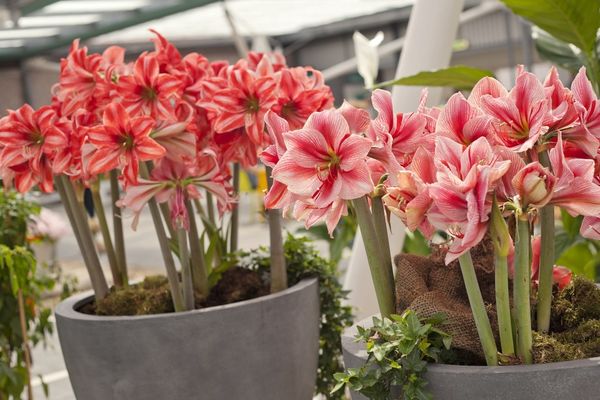
Pot
The hippeastrum has a well-developed root system, so a flowerpot is selected that can accommodate both the bulb and the root. In addition, there must be a drainage hole in the container to drain excess moisture.
Attention! A drainage layer will be placed on the bottom of the pot for the same purpose - to prevent the accumulation of water.
To ensure flowering, do not take a pot that is too wide: it is enough that there is about 3 cm of soil between the bulb and the walls. Therefore, it is worth picking up a narrow but deep flowerpot with a drainage hole.
Priming
For a successful growing season, a loose nutrient soil is selected. You can purchase a ready-made substrate for bulbous plants, but it is not forbidden to mix the substrate yourself.
For this you will need:
- 2 pieces of garden land;
- 1 part peat;
- 1 part of humus;
- 1 part sand.
To increase the friability, you can add brick chips.

Top dressing and fertilization
At the time of rest, no fertilizers are applied; during this period, the plant should be allowed to rest and gain strength. The first top dressing is recommended when the arrow of the hippeastrum outgrows 15 cm in length. Then feeding is carried out every 3 weeks.
It is not worth using nitrogen fertilizers - this will cause an increase in green mass and stop flowering. To stimulate the release of peduncles, potassium-phosphorus complexes are recommended.
When and how to replant
It is not recommended to transplant a flower more often than once every 3 years. It is better to change the land in early January, timing the transplant to the end of the dormant period.
Important! When handling, try not to damage the bulb. It cannot be completely buried in the substrate: about a third should be above the ground.
Pruning
Dried leaves and peduncles are cut off when the last "gramophone" has faded. You need to wait until the aerial part is completely dry and the nutrients go into the bulb.

Dormant period
After the leaves have dried and removed, the hippeastrum enters a dormant period. It lasts until early - mid-January. Hibernation features:
- do not water;
- do not feed;
- they look for a cool shaded corner of the bulb in a pot and lay it on one side.
In this form, the bulb is stored until January.
Dormant period
If it is decided not to leave the plant to winter in the open field, it must be provided with the proper temperature regime. It is best for the bulbs to be kept in a cool room, where the optimum temperature will be 15 ° C. In this case, it is worth making sure that it is kept within the range of + 10 ... + 18 ° С. Care must be taken not to freeze the plant: temperatures below 10 ° C can cause the development of diseases, and below 5 ° C it can completely destroy the flower. Temperatures above 18 ° C will not kill the plant, but will cause the bulbs to germinate too quickly. And this means that the period of rest in the hippeastrum is questionable, he will not get a full rest.

Plants "fall asleep" when planted in a pot, but this can be omitted. In this case, they need to be stored on their side, sprinkled with sawdust, and at the same time leave the foliage. The temperature regime is the same. It is allowed to store bulbs in the refrigerator, in the vegetable compartment. Pre-wrap them in paper and make sure that any moisture is blocked off to them, otherwise there is a risk of rot in the planting material. By storing the bulbs this way, you can achieve an earlier flowering of the plants, but they can also dry out.
Summarizing all of the above, you can get the following ideal conditions for the so-called South African winter of the hippeastrum:
- darkened room;
- temperature about 15 ° C;
- lack of liquid and moderate humidity.
The rest period with the fulfillment of all conditions lasts from 4 to 12 weeks, this is the first stage of forcing the bulbs. It is impossible to predict the exact duration, since everything depends on the "past life" of the flower, the intensity of its budding and the peculiarities of leaving after it. At the second stage, the plant is taken to a warm, dark place and watered abundantly once. The soil must be completely saturated with moisture. Now you need to forget about the hippeastrum for 1-2 weeks, only periodically keeping the soil moist. When the hippeastrum begins to germinate and release the peduncle, it must be placed in a sunny place, for example, on a windowsill, and regular watering must be resumed.

If the hippeastrum, already faded and in a dormant period in a darkened place, continues to give leaves, then there can be two reasons for this
You need to pay attention to the sprouted bulb:
- 1If it is dense, does not look emaciated, then the plant is already well rested and ready to give flowers.
- 2 The bulb may be firm, but with flabby scales. In this case, she was sent to rest too early. It is better to plant it again, continuing to actively fertilize and water. After some time, such a bulb will wake up and release its first leaf, and then the peduncle.
It is required to remember that only healthy, dense, nourished bulbs that have managed to regain their strength after the last flowering must be sent to rest.
Answers to popular questions
More often than not, amateurs ask the same questions. We offer a small educational program for beginners.
Why is it growing poorly?
If there was no full-fledged winter rest, where would the plant get the strength for growth, and even more so for the ejection of peduncles? It is strange to expect active development from an exhausted pet.

The reason may lie in:
- poor lighting;
- depleted soil;
- lack of moisture.
How to wake up a bulb after hibernation?
A couple of weeks after the New Year, the hippeastrum is transferred to its rightful place. After waiting for the first arrow to appear, they begin to water again (very moderately at first). After about 3 weeks, you can start feeding.
How to rejuvenate an onion?
The procedure is complex, but effective:
- at the end of flowering in November, cut off the part of the bulb that is above the ground;
- clean off all outer layers;
- make vertical cuts crosswise;
- separate the segments from each other;
- regularly moisten the soil.
Six months later, new "kids" are formed on the segments.
How do you know if a flower is depleted?
Signs will be a weak flowering, and in especially neglected cases - a complete absence of peduncles. When transplanting, it is noticeable that the bulb has decreased in size and looks dried out.
How to reanimate?
When diseases develop, it is important to determine the number of diseased bulbs and isolate them from healthy plants. Sick scales are removed from the affected specimen, rotten areas are cut off with a sharp knife with a sterilized blade
Sick scales are removed from the affected specimen, rotten areas are cut off with a sharp knife with a sterilized blade.
It is not superfluous to treat with an antifungal drug (for example, "Maxim" or the like) and dry well. Then the bulb can be planted in the substrate and sprinkled with "Fundazol". Water in moderation.

Caring for a withering plant

So, your hippeastrum has faded, what should you do next? The essence of care is to create favorable conditions for the bulb to regain strength and become ready again for the next flowering.
To do this, from mid-September, stop watering, wait until the entire aerial part of the plant withers completely.
Cut the stems to a height of 15 centimeters from the edge of the bulb.
What to do with the boom? As soon as the remaining part of the peduncle is completely dry, carefully remove it by scrolling.
Place the pot with hippeastrum in a dark place where the air temperature is from ten to thirteen degrees Celsius.

This is the most optimal mode for hibernation of the bulb. In these conditions, it should remain until the end of January or the beginning of February. The bulb takes time and previous living conditions to awaken. Simply put, return the pot to where it stood before the plant hibernated, and proceed to the previous care regimen.
The flowering of hippeastrum is a complex process that requires enormous efforts of the bulb. Strength, however, it can acquire only under the condition of being in nutrient-rich soil. You should fertilize this soil and change it periodically.
With one flowering of hippeastrum per year, the time for recuperation of the bulb is nine months. More frequent flowering can be achieved if the plant is not allowed to rest, but from this the bulb will soon be unable to give flowers.
Bloom festival
Often in flower shops they sell sprouted bulbs with a peduncle 4-5 cm high. They will begin to bloom in 30-35 days.
If you bought a sleeping bulb (the flower arrow did not start to sprout), then you decide for yourself when to arrange a flowering holiday, since another advantage of this indoor bulb is the ability to plan the flowering time yourself. After 1-2 years of cultivation, flowering can be obtained with an accuracy of 1-2 days by a certain date - for example, by a birthday. From the moment the dormant bulb is planted to the emergence of the peduncle, no more than 2 weeks pass for all varieties (at a temperature of 18-22 °). And then, depending on the variety, flowering begins in 30-45 days.
The container for planting must be selected with a diameter of 2-3 cm larger than the size of the bulb itself. Low flat pots are preferable to tall, elongated ones. A drainage hole is required, since the main enemy of the hippeastrum is excess moisture in the soil. Therefore, when planting, the bulbs are buried only halfway.
As a soil, a universal substrate for indoor plants based on lowland peat with an acidity close to neutral is suitable, or a more nutritious soil option for flowering indoor plants.
It is important to know that in too large a container and with frequent watering, the leaves will outstrip the flower arrow in growth. The most beautiful specimens with short and strong peduncles and short leaves are obtained by keeping the soil dry.
The optimal watering regime is no more than 1-2 times a week and only from below, through the pallet.
Before flowering, no additional dressings are carried out so as not to provoke a strong stretching of the leaves.
The container is placed in a bright place at a temperature of 18-22 °. Hippeastrum is a light-loving plant, but prepared bulbs bloom well even on a shaded northern windowsill.

